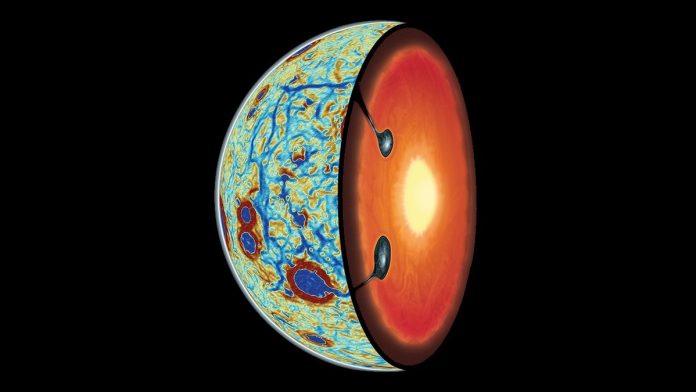
Scientists have long been fascinated by a mysterious chapter in the Moon’s past, and now, new research may have finally shed light on this puzzle.
Picture this: billions of years ago, the Moon was just a fiery, molten sphere, born from a colossal clash between Earth and another celestial body.
This young Moon was covered by a vast ocean of magma. As it cooled, the minerals began to settle – the heaviest sank to form the core, while lighter materials floated up to craft the Moon’s initial crust.
However, a recent study published in Nature Geoscience suggests a dramatic twist occurred during the Moon’s early days.
It appears that the Moon’s mantle – the layer beneath the crust – did a complete flip! Imagine a cake with several layers flipping upside down, and you’ve got a good picture.
Here’s how it happened: At the tail end of its cooling period, a thick, dense mineral called ilmenite formed at the top of the mantle. Being heavier than the rocks below it, ilmenite sank down, flipping the mantle in the process.
This fascinating theory has been around for decades, based mostly on computer simulations and analysis of Moon rocks collected during the Apollo missions. But now, thanks to data from NASA’s GRAIL mission, we have the first physical evidence.
GRAIL, which stands for Gravity Recovery and Interior Laboratory, was a mission where two spacecraft flew around the Moon to measure tiny changes in its gravity.
More than a decade ago, GRAIL detected unusual gravity patterns on the Moon’s surface.
These patterns showed a polygonal shape and were centered around the dark plains on the Moon’s nearside, known as lunar maria.
These gravity anomalies puzzled scientists for years until the recent breakthrough. By simulating the behavior of the sinking ilmenite, researchers realized that the patterns matched the GRAIL data. It turns out the dense ilmenite didn’t just sink; it broke into flat sheets and cascaded downward like waterfalls, eventually cooling and solidifying in place.
These frozen cascades of ilmenite tell a story of the Moon’s past, particularly about the mantle’s viscosity – essentially how thick and flowy it was billions of years ago.
Think of it like honey heating in a pot: as it warms, it flows easier and might form bubbles. If the honey suddenly cools, those bubbles are trapped, showing how fluid it was just moments before.
The research team even pinpointed when this mantle flip likely occurred. By dating lunar impact basins, they suggest the ilmenite cascades formed over 4.22 billion years ago.
This timing lines up with a surge in volcanic activity, which brought titanium-rich lava (originally part of the ilmenite) back to the lunar surface.
Interestingly, GRAIL didn’t find similar anomalies on the Moon’s farside, which has a thicker crust. This suggests the ilmenite might not have formed there, or perhaps it moved toward the nearside due to a large impact.
The implications of this research are vast, not just for understanding the Moon, but for planetary formation in general. And with NASA’s upcoming Artemis III mission targeting the Moon’s South Pole-Aitken basin, we might just gather the samples needed to delve deeper into this geological mystery.



